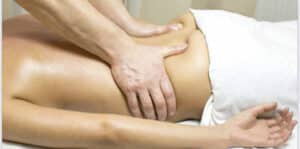This post introduces issues with hip strength, and points to Patient Advice Notes which give practical help to improve your health. These Patient Advice Notes have been produced and reviewed by physiotherapists, and while no substitute for a proper consultation, may help when you see a therapist.
A handout of this article is available here.
When talking about ‘hips’ we can end up falling into some of the most ambiguous terms in athletic performance!
Tight hips, loose hips, strong hips, weak hips – these phrases get tossed around frequently and not only in the sporting world. Does the average person have any idea what they actually mean? It can pose a serious dilemma because if someone doesn’t understand an issue, they won’t be motivated to address it.
 Unless you’re a candidate for a hip replacement, when someone talks about your hips they aren’t talking about the actual bones. They are more likely to be referring to groups of muscles that cause movement in and around the hip joint. There are roughly 17 of these muscles and they’re often divided into large groups depending on what they do.
Unless you’re a candidate for a hip replacement, when someone talks about your hips they aren’t talking about the actual bones. They are more likely to be referring to groups of muscles that cause movement in and around the hip joint. There are roughly 17 of these muscles and they’re often divided into large groups depending on what they do.
Extensors – pull your leg back behind you
Rotators – cause both inward (internal, pigeon toed) and outward (external, duck or ballerina stance) rotation of your leg
Flexors – pull your leg forwards in front of you or lift it off the ground
Adductors – squeeze your legs together or cross your leg over the midline to the other side
Abductors – pull or lift your leg out to the side away from the middle of your body (your midline)
Studies have shown that small increases in hip muscle strength can result in significant improvements in sprinting and running performance. It is thought that the foundation for good running performance starts with your hips. If you can hold a good, athletic posture while moving forwards, backwards, side-to-side or rotating – that’s a sign of strong hips.
Not only do the muscles in and around your hips play a critical role in performance, they also help you stay injury free. Research shows not only better performance in athletes with stronger hips but also fewer injuries to the lower back and lower limbs.
Having weak hips causes a lack of full range of motion which leads to muscular imbalances. This can, in turn, cause faulty mechanics, poor movement patterns or in some cases shearing forces on opposing muscles potentially causing injury. Weak hips cause a ripple effect of improper mechanics throughout the body, meaning they can greatly increase your risk of overall injury.
THERE IS AN EPIDEMIC OF WEAK HIPS – BUT WHY?
Part of the reason for this can be traced to our lifestyle. Although those with desk jobs are our society’s biggest sitters, anyone can find themselves in a seated position for the vast majority of their days. Whether you’re sitting in class, studying, gaming, driving
or taking public transport – the odds are you’re in a seated position with your hands in front of you, your hip flexors (the muscles on the front) are shortened and your hip extensors (essentially your buttocks) are lengthened. Spending large amounts of time in positions like these can lead to postural problems, muscle imbalances and weakness.
For a handout on hip mobilising exercises, click here.
Specifically, hip abductor muscle weakness is not only common but can have knock-on effects throughout your lower limbs and back. Hip abduction is used every day when you step to the side, get out of bed and get out of the car. It’s not just that the hip abductors are important and often forgotten muscles, they contribute to your ability to stand, walk and rotate your legs with ease. The hip abductors are also necessary for stabilising the pelvis when walking or standing on one leg (which happens when climbing stairs or even running). Weakness in these muscles can cause pain and interfere with proper movement. The hip abductor muscles include the gluteus medius, gluteus minimus and tensor fascia latae.
WHAT CAUSES WEAK HIP ABDUCTORS – AND WHAT DO WEAK HIP ABDUCTORS CAUSE?
Hip muscle weakness can be a result of your lifestyle. I am positive that cavemen busy hunting and gathering on the African plains 50,000 years ago never complained of weak hip abductors. The hip abductors are closely related to the core muscles and are crucial for balance and athletic activity. As a result of extended time spent sitting during the day, many people develop weak gluteal (buttock) muscles, which include the hip abductors.
For a handout on hip abductor activation exercises click here.
Being inactive for a long time can lead to the body essentially ‘turning off’ these muscles, making them harder to use (activate) during exercise. This can make your body resort to using other muscles not meant for those tasks. Using the wrong muscles can lead to pain, poor performance and difficulty with certain movements. Hip abductor weakness can lead to overuse injuries like patellofemoral pain syndrome (pain behind the kneecap) and iliotibial band syndrome (ITBS). It’s not clear whether hip abduction weakness is a cause of or a result of knee problems. Findings about the relationship between hip abduction and knee issues are mixed. In general, however, strengthening these muscles delivers benefits in reducing pain and improving function.
Quite often it is a case of the chicken or the egg, especially in athletes or people who are physically active. Pain or a past injury to the hip, knee or even foot can result in changes to a person’s gait (how they walk) over time. This in turn alters the way you recruit and use your muscles, possibly causing weakness in certain groups. Contrary to this an underlying weak hip abductor muscle can result in changes to the person’s biomechanics and joint alignment which in turn brings on pain, wear and tear on a joint possibly causing osteoarthritis in the hip or knee.
Hip tendonitis, tendinopathy or abductor tears are often caused by overuse through playing sports that require a lot of jumping. This can be an acute injury (in the case of a weekend warrior) or chronic overuse. Tendonitis of one of the abductor muscles can also be caused if the nearby supporting muscles are too weak or too strong, causing a muscle imbalance. Tendon overuse can also cause micro-tears in the tendon or muscle belly itself.
Knee valgus refers to when the knees cave inward, giving a ‘knock-kneed’ appearance. This is most commonly seen in young women and older adults or in those with muscle imbalances or improper form during exercise. Knee valgus is associated with a lack of hip strength and studies have shown that hip abduction exercises can improve the condition.
The gluteus medius muscle is susceptible to the development of myofascial pain syndrome. Such pain most often occurs as a result of repetitive microtrauma to the muscle from activities such as running and overuse of exercise equipment or other repetitive activities that require hip abduction. Trigger points (painful ‘knots’ in the muscle) that develop within the muscle can refer pain around the hip, down the leg and into the groin area and buttocks. This referred pain can often lead to misdiagnoses or be attributed to other organ systems, thereby leading to extensive evaluations and ineffective treatment.
There can be other medical reasons one may have weak abductor muscles:nerve injury or nerve entrapment; dysplasia of the hip, congenital dislocation of the hip, congenital coxa vara or coxa valga, slipped capital femoral epiphysis (here the muscle is normal but it is at a mechanical disadvantage); following hip replacement surgery, or femoral fixation (after femur or neck of femur fracture); and muscular dystrophy, cerebral palsy, stroke or hemiplegia.
HOW DO YOU KNOW IF YOU HAVE WEAK HIP ABDUCTORS?
If any of the situations or scenarios mentioned above sparked a thought (even a small ‘ahaaaa’), then visit your local physical therapist to be assessed. A simple assessment looking for a Trendelenburg sign can be done in the consultation room. More advanced tests can be performed to assess muscle weakness but for the majority of patients no fancy investigations would be needed.
For a handout on Trendelenbury Gait click here.
 MANAGEMENT
MANAGEMENT
Not only can hip abduction exercises help you get a tight and toned backside, they can also help to prevent and treat pain in the hips and knees.
1. Mobility
Mobility would be the ability to actively move through a range of motion and be stable through that range of motion. Lots of young athletes may be really flexible, but they can’t control their own bodies through that range of motion. Contrary to that, and often due to our sedentary lifestyle, many people have tight, stiff hip joints and lack mobility through their lower back into their legs. Specific stretching exercises can be prescribed by your physical therapist to release tight structures like hip flexors and rotator muscles.
2. Strength
Clearly the problem is muscle weakness and therefore it’s a no brainer that you need to do strengthening exercises to restore normal function. Your physical therapist can prescribe these for you based on your needs. As mentioned, hip abductor strength training has proven to reduce pain and improve function, as well as improve athletic performance!
For handouts on improving hip abductor strength click here and here.
3. Hands-On Therapy
Massage, myofascial release, trigger point therapy, dry needling, fascial work can all help release tight painful hip abductors.
A weak muscle fatigues (gets tired) easily and often goes into ‘spasm’ seen as tight painful bands or trigger points in the muscle. Manual therapy to the muscle and surrounding areas can relieve pain and improve mobility.
4. Be Active
Never underestimate the power of a good walk. Going for a ‘pure’ walk (no running at all) allows your body to make small adaptations that strengthen your feet, knees and hips. Walking uphill is even better for your hip muscles and so choose to take the stairs where possible.
5. Look at the Cause and Treat It
Find the cause of the problem and also ensure that it is treated:
* The weekend warrior, who subjects their body to unaccustomed physical activity – instigate better planning, a progressive training programme.
* Poor posture while sitting at work, computer or watching TV, etc.
* Poor recovery from past injury or surgery – ensure full recovery by completing your rehabilitation programme.
* Other predisposing factors may include poor nutritional status, poor sleep quality or coexisting psychological or behavioural abnormalities, including chronic stress and depression. The gluteus medius muscle seems to be particularly susceptible to stress-induced myofascial pain syndrome.
* Foot orthotics or biomechanics – how you use your feet and your foot posture affects your knee and hip alignment and therefore muscle recruitment.
THE TAKEAWAY
Hip abduction exercises can offer many benefits. These exercises help strengthen important muscles needed for stabilisation around your hip and pelvis, and help prevent injuries occurring anywhere from your lower back to your foot!
The information contained in this article is intended as general guidance and information only and should not be relied upon as a basis for planning individual medical care or as a substitute for specialist medical advice in each individual case.






